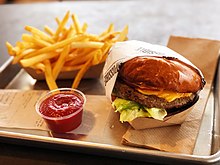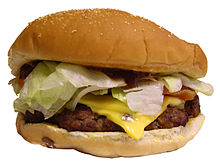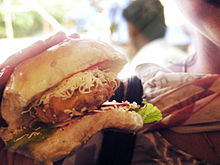Hamburger
A hamburger, or simply a burger, is a dish consisting of fillings—usually a patty of ground meat, typically beef—placed inside a sliced bun or bread roll.The patties are often served with cheese, lettuce, tomato, onion, pickles, bacon, or chilis with condiments such as ketchup, mustard, mayonnaise, relish or a "special sauce", often a variation of Thousand Island dressing, and are frequently placed on sesame seed buns.[9] The 1758 edition of the book The Art of Cookery Made Plain and Easy by Hannah Glasse included a recipe called "Hamburgh sausage", suggesting that it should be served "roasted with toasted bread under it."[13] The invention of hamburgers is commonly attributed to various people, including Charlie Nagreen, Frank and Charles Menches, Oscar Weber Bilby, Fletcher Davis, or Louis Lassen.[16] Some have pointed to a recipe for "Hamburgh sausages" on toasted bread, published in The Art of Cookery Made Plain and Easy by Hannah Glasse in 1758.[24] Frank Menches's obituary in The New York Times states that these events took place at the 1892 Summit County Fair in Akron, Ohio.According to oral histories, in the 1880s, he opened a lunch counter in Athens and served a 'burger' of fried ground beef patties with mustard and Bermuda onion between two slices of bread, with a pickle on the side.[15] Historian Frank X. Tolbert noted that Athens resident Clint Murchison said his grandfather dated the hamburger to the 1880s with Fletcher "Old Dave" Davis.In the United States, the hamburger patties served by major fast food chains are usually mass-produced in factories and frozen for delivery to the site.At conventional American restaurants, hamburgers may be ordered "rare" but normally are served medium-well or well-done for food safety reasons.The McDonald's fast-food chain sells the Big Mac, one of the world's top-selling hamburgers, with an estimated 550 million sold annually in the United States.[42] Raw hamburgers may contain harmful bacteria that can produce food-borne illnesses such as Escherichia coli O157:H7, due to the occasional initial improper preparation of the meat, so caution is needed during handling and cooking.[50] In the U.S. in 1934, A.H. "Gus" Belt, the founder of Steak 'n Shake, devised a higher-quality hamburger and offered it as a "steakburger" to customers at the company's first location in Normal, Illinois.[62] Some baseball parks concessions in the United States call their hamburgers steak burgers, such as Johnny Rosenblatt Stadium in Omaha, Nebraska.Condiments might be added to a hamburger or may be offered separately on the side, including ketchup, mustard, mayonnaise, relish, salad dressings and barbecue sauce.In 2012, according to a study by the NDP cabinet, the French consume 14 hamburgers in restaurants per year per person, placing them fourth in the world and second in Europe, just behind the British.[84] In Mexico, burgers (called hamburguesas) are served with ham[85] and slices of American cheese fried on top of the meat patty.Some restaurants' burgers also have barbecue sauce, and others replace the ground patty with sirloin, Al pastor meat, barbacoa, or fried chicken breast.Burgers from this type of outlet are usually served without any form of salad — only fried onions and a choice of tomato ketchup, mustard, or brown sauce.These are usually high-quality minced steak patties topped with things such as blue cheese, brie, avocado, anchovy mayonnaise, et cetera.In the early 21st century, "premium" hamburger chains and independent restaurants have arisen, selling burgers produced from meat stated to be of high quality and often organic, usually served to eat on the premises rather than to take away.[89] In the UK, as in North America and Japan, the term "burger" can refer simply to the patty, be it beef, some other kind of meat, or vegetarian.Likewise, McDonald's in New Zealand created a Kiwiburger, similar to a Quarter Pounder, but features salad, beetroot, and a fried egg.This has led to confusion when Chinese nationals try to order sandwiches with meat fillings other than beef in fast-food restaurants in North America.[97] Burger King once retreated from Japan, but re-entered the market in summer 2007 in cooperation with the Korean-owned Japanese fast-food chain Lotteria.[99] Today, the bøfsandwich, flæskestegssandwich, and their many variations co-exist with the more typical hamburger, with the opening of the first Burger King restaurant in 1977 popularizing the original dish in Denmark.The chain McDonald's (locally nicknamed "McDo") has a range of burger and chicken dishes often accompanied by plain steamed rice or French fries.Another version of the Indian vegetarian burger is the wada pav, consisting of a deep-fried potato patty dipped in gram flour batter.In Turkey, in addition to the internationally familiar offerings, numerous localized variants of the hamburger may be found, such as the Islak Burger (lit."Wet-Burger"), which is a beef slider doused in seasoned tomato sauce and steamed inside a special glass chamber, and has its origins in the Turkish fast food retailer Kizilkayalar.















Hamburger (disambiguation)Main courseGermanyUnited StatesGround meatbread rollcondimentsrelishThousand Island dressingsesame seed bunscheeseburgersandwichfast-food restaurantsdinersvariationsMcDonald'sBig MacBurger King'sWhopperAmerican cultureHamburgrebracketingsandwichesbuffalobuffalo burgervenisonkangaroochickenturkeysalmonsalmon burgerveggie burgerportobellochicken sandwichHistory of the hamburgerHistory of the hamburger in the United StatesHamburg steakFrikadelleThe Art of Cookery Made Plain and EasyHannah GlasseRundstück warmHamburg America LineThe Boston JournalWhite Castle1904 St. Louis World's FairABC NewsThe Washington PostRosa DeLauroLouis' LunchNew HavenNew Haven, Connecticutsteak sandwichNew York MagazineCharlie NagreenSeymour, WisconsinFrank KeatingTulsa, OklahomaHamburg, New YorkThe New York TimesAkron, OhioAthens, TexasDelmonico'sSan Fernando, CaliforniaHistory of McDonald'sWichita, KansasKewpee HamburgersFlint, MichiganWorld War IIWhite Tower HamburgersLittle TavernKrystalBig BoySan Bernardino, CaliforniaRichard and Maurice McDonaldSpeedee Service Systemfast-food restaurantRay Krocfast foodrestaurantsground beefWendy'sBurger KingHungry Jack'sCulver'sWhataburgerCarl's Jr.Hardee'sJack in the BoxCook OutHarvey'sHesburgerSupermac'sShake ShackIn-N-Out BurgerFive GuysFatburgerBurgervilleBack Yard BurgersLick's HomeburgerRoy RogersSmashburgerFuddruckersRed RobinBobby's Burger PalaceFood NetworkBobby Flaytextured vegetable proteinammonia treated defatted beef trimmingsBeef Productsadvanced meat recoveryfillersbreadcrumbsparsleysoy sauceonion soupWorcestershire sauceseasoned saltBloomberg Newswell-doneList of hamburgersostrichImpossible Burgermeat analogueseitanEurasianIndian cuisine



